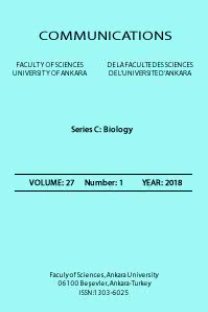CHARACTERIZATION OF ITS1 SECONDARY STRUCTURE IN TEN SPECIES OF COLUTEOCARPEAE (BRASSICACEAE) AND ITS TAXONOMICAL UTILITY
Coluteocarpeae, Brassicaceae, secondary structure, ITS1
___
Hillis, D.M., Dixon M. T., Ribosomal DNA: molecular evolution and phylogenetic inference, The Quarterly review of biology, 66 (4) (1991), 411-453.Warwick, S.I., Mummenhoff, K., Sauder, C.A., Koch, M.A., Al-Shehbaz, I.A., Closing the gaps: phylogenetic relationships in the Brassicaceae based on DNA sequence data of nuclear ribosomal ITS region, Plant Systematics and Evolution, 285 (3-4) (2010), 209-232. https://doi.org/10.1007/s00606-010-0271-8.
Baldwin, B. G., Sanderson, M. J., Porter, J. M., Wojciechowski, M. F., Campbell, C. S., Donoghue, M. J., The ITS region of nuclear ribosomal DNA: a valuable source of evidence on angiosperm phylogeny, Annals of the Missouri Botanical Garden, (1995), 247-277.
Musters, W., Boon, K., Van der Sande, C. A., van Heerikhuizen, H., & Planta, R. J., Functional analysis of transcribed spacers of yeast ribosomal DNA, The EMBO journal, 9 (12) (1990), 3989-3996. https://doi.org/10.1002/j.1460-2075.1990.tb07620.x
Mai, J. C., Coleman, A. W., The internal transcribed spacer 2 exhibits a common secondary structure in green algae and flowering plants, Journal of Molecular Evolution, 44 (3) (1997), 258-271.
Coleman, A. W., Is there a molecular key to the level of “biological species” in eukaryotes? A DNA guide, Molecular phylogenetics and evolution, 50(1) (2009), 197-203. https://doi.org/10.1016/j.ympev.2008.10.008.
Wolf, M., Chen, S., Song, J., Ankenbrand, M., Müller, T., Compensatory base changes in ITS2 secondary structures correlate with the biological species concept despite intragenomic variability in ITS2 sequences–a proof of concept, PloS one,8(6) (2013), e66726. https://doi.org/10.1371/journal.pone.0066726.
Coleman, A. W., Vacquier, V. D., Exploring the phylogenetic utility of ITS sequences for animals: a test case for abalone (Haliotis), Journal of molecular evolution, 54(2) (2002), 246-257. https://doi.org/ 10.1007/s00239-001-0006-0.
Mullineux, T., Hausner, G., Evolution of rDNA ITS1 and ITS2 sequences and RNA secondary structures within members of the fungal genera Grosmannia and Leptographium, Fungal Genetics and Biology, 46(11) (2009), 855-867. https://doi.org/10.1016/j.fgb.2009.08.001.
Saha, P. S., Sengupta, M., Jha, S., Ribosomal DNA ITS1, 5.8 S and ITS2 secondary structure, nuclear DNA content and phytochemical analyses reveal distinctive characteristics of four subclades of Protasparagus, Journal of Systematics and Evolution, 55(1) (2017), 54-70. https://doi.org/10.1111/jse.12221.
Karpenko, N., Martyniuk, V., Tyshchenko, O., Tarieiev, A., Tekpınar, A., Didenko, V., Kostikov, I., Resolving the position of Astragalus borysthenicus Klokov within the Astragalus L. species, Turkish Journal of Botany, 42(5) (2018), 623-635. https://doi.org/10.3906/bot-1712-52.
Liu, J. S., Schardl, C. L., A conserved sequence in internal transcribed spacer 1 of plant nuclear rRNA genes, Plant molecular biology, 26(2) (1994), 775-778.
Nues, R. W., Rientjes, J. M., van der Sande, C. A., Zerp, S. F., Sluiter, C., Venema, J., Planta, R. J., RauØ, H. A., Separate structural elements within internal transcribed spacer 1 of Saccharomyces cerevisiae precursor ribosomal RNA direct the formation of 17S and 26S rRNA, Nucleic acids research, 22(6) (1994), 912-919. https://doi.org/10.1093/nar/22.6.912.
Rampersad, S. N., ITS1, 5.8 S and ITS2 secondary structure modelling for intra-specific differentiation among species of the Colletotrichum gloeosporioides sensu lato species complex, Springer Plus 3(1) (2014), 684. https://doi.org/10.1186/2193-1801-3-684.
Meyer, F.K., Conspectus der “Thlaspi”-Arten Europas, Afrikas und Vorderasiens., Feddes Repertorium, 84 (1973) 449-469.
Meyer, F.K., Kritische Revision der Thlaspi ︁‐Arten Europas, Afrikas und Vorderasiens I. Geschichte, Morphologie und Chorologie, Feddes Repertorium, 90(3) (1979), 129-154.
Ali, T., Schmuker, A., Runge, F., Solovyeva, I., Nigrelli, L., Paule, J., Buch, A.N., Xia, X., Ploch, S., Orren, O., Kummer, V., Linde-Laursen, I., Ҫelik, A., Thines, M., Morphology, phylogeny, and taxonomy of Microthlaspi (Brassicaceae: Coluteocarpeae) and related genera., Taxon, 65(1) (2016), 79-98. http://dx.doi.org/ 10.12705/651.6.
https://brassibase.cos.uni-heidelberg.de/, accessed 02 November 2020.
Al-Shehbaz, I. A., A synopsis of the genus Noccaea (Coluteocarpeae, Brassicaceae), Harvard papers in Botany 19(1) (2014), 25-51. https://doi.org/10.3100/hpib.v19iss1. 2014.n3.
Özüdoğru, B., Özgişi, K., Tarıkahya-Hacıoğlu, B., Ocak, A., Mummenhoff, K., Al-Shehbaz, I. A., Phylogeny of the Genus Noccaea (Brassicaceae) and a Critical Review of Its Generic Circumscription1, 2, Annals of the Missouri Botanical Garden, 104(3) (2019), 339-354. https://doi.org/10.3417/2019347.
Greuter, W, Raus, T, Med-checklist notulae 7., Willdenowia (1983), 79-99.
Greuter, W., Burdet, H. M., Long, G., Med-checklist, Conservatoire et Jardin Botaniques de la Ville de Genève, Ginebra, vol. 3, (1986).
Al-Shehbaz, I.A., The genera of Lepidieae (cruciferae; Brassicaceae) in the southeastern United States., Journal of the Arnold Arboretum, 67(3) (1986), 265-311.
Özgişi, K. Structural characterization of ITS2 and CBC species concept applications in the tribe Coluteocarpeae (Brassicaceae), Turkish Journal of Botany, 44(3) (2020), 295-308. http://dx.doi.org/10.3906/bot-1911-4.
Meyer, F. K.. Kritische Revision der “Thlaspi”-Arten Europas, Afrikas und Vorderasiens, Spezieller Tiel, VIII. Raparia F.K.Mey, Haussknechtia 11(2006), 195–206.
White, T. J., Bruns, T., S. L., Taylor, J., Amplification and direct sequencing of fungal ribosomal RNA genes for phylogenetics., PCR protocols: a guide to methods and applications, 18(1) (1990), 315-322.
Warwick, S. I., Al-Shehbaz, I. A., Sauder, C.A., Murray, D. F., Mummenhoff, K., Phylogeny of Smelowskia and related genera (Brassicaceae) based on nuclear ITS DNA and chloroplast trnL intron DNA sequences, Annals of the Missouri Botanical Garden, (2004), 99-123.
Edgar, R.C., MUSCLE: multiple sequence alignment with high accuracy and high throughput., Nucleic acids research, 32(5) (2004), 1792-1797. https://doi.org/10.1093/ nar/gkh340.
Zuker, M., Mfold web server for nucleic acid folding and hybridization prediction, Nucleic acids research, 31(13) (2003), 3406-3415. https://doi.org/10.1093/nar/gkg595.
Xia, T., Mathews, D.H., Turner, D.H., Thermodynamics of RNA secondary structure formation, RNA, (2001), 21-48.
Edger, P. P., Tang, M., Bird, K. A., Mayfield, D. R., Conant, G., Mummenhoff, K., Koch, M.A., Pires, J.C., Secondary structure analyses of the nuclear rRNA internal transcribed spacers and assessment of its phylogenetic utility across the Brassicaceae (Mustards)., PloS one 9(7) (2014), e101341. https://doi.org/10.1371/ journal.pone.010 1341.
Slotta, T.A.B., Phylogenetic analysis of Iliamna (Malvaceae) using the Internal Transcribed Spacer region. Virginia Polytechnic Institute and State University, Thesis, (2000).
- ISSN: 1303-6025
- Yayın Aralığı: Yılda 2 Sayı
- Başlangıç: 1943
- Yayıncı: Ankara Üniversitesi
TAXONOMIC CONTRIBUTIONS TO THE GENUS DIANTHUS (CARYOPHYLLACEAE) FROM TURKEY
Ayşe İKİNCİ KELEŞ, Hüseyin Serkan EROL, Tuğçe SAPMAZ, Tolga MERCANTEPE, Gökhan KELEŞ, Burcu BİTERGE SÜT, Ersan ODACİ, Mesut HALICI, Sait POLAT
İlker BÜYÜK, Aybüke OKAY, Taner AKSOY, Sumer ARAS
Mehmet Kürşat ŞAHİN, Muammer KURNAZ
ALTERATIONS OF ALDOSE REDUCTASE ACTIVITY BY INDOLE-3-CARBOXALDEHYDE DERIVATIVES
